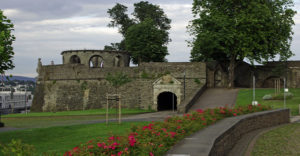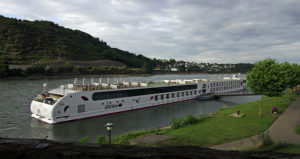Only two Cornish churches rate four stars for Simon Jenkins in “England’s Thousand Best Churches.” Pevsner had remarked the “barbarous profusion” of the exterior sculptures and decoration of Launceston. It was this rather than the medieval glass of St Neot that attracted me.
We had hoped to visit Cotehele on our way but it wasn’t open until 11 am, so with a long journey ahead and threatening weather we settled for the church of St Mary. To reach it we had to navigate one way streets, avoiding the town gate and (only just!) missing a wall in almost the last space in the car park. Pedestrian zones are all very well but a little more generous provision for parking would be appreciated, even by travellers accustomed to Cambridge.
At least we didn’t have the French problem of traffic free zones being anything but. It was only a short walk to the church: in fact it appeared almost unexpected without a space between its porch and the street. We were so close we could have missed St George and the dragon over the porch. That noticed, however, there was no chance the shields, quatrefoils, flowers and mottoes of the exterior would shrink from view. A photographer’s paradise but a stonemason’s nightmare, these are carved in granite of a hardness emphasised by the near blackness of the stone.
Thinking of the labour involved it makes me wonder if local poet Charles Causley hadn’t had a stonemason’s son in one of his classes. The intensity of it would have made for a “A blitz of a boy.”
That said, the results of such labour have to be admired, as it’s difficult not to admire the energy of a Timothy Winters, or the real pupil who, when Causley introduced Ted Hughes to his school as “a far better poet than I’ll ever be,” bellowed: “Oh, no he ain’t.” There was to be an event at a nearby home that Causley had admired but we were not able to attend, so back to the church.
Inside is twentieth century timber work: a gothic rood screen and reredos. The pulpit is painted black with gold details and a red and green stem. Foliage, as outside, is profuse. The bench ends illustrate the works of God. The roof is a typically Cornish barrel vault but with carvings of angels and it seems more than 400 bosses.
We also found one brass and a small medieval memorial to admire before making our way outside and around the town square. Looking for a way back to the carpark we noticed a sign for the castle. Launceston was ready for defence during the Civil War but the need failed to materialise. A view through the gate towards what is left of the keep shows it would have been formidable.















